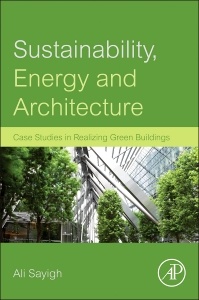Description
Sustainability, Energy and Architecture
Case Studies in Realizing Green Buildings
Author: Sayigh Ali
Language: English
Keywords
Africa; Bedouins; Circadian biorhythm; Dubai; Energy Efficiency in Buildings; Hot Climates; Larsen Truss; Sustainable Architecture; Tent; The corporate sustainable image; bioclimatic design; building; building performance; carbon emissions; commercial and institutional buildings; coulours; daylight availability; eco-efficiency; energy efficiency; energy load; glazing; global warming; governmental policy; green building; insulation; life cycle analysis; lighting control; low energy building; low energy housing; neighborhood; net zero energy buildings; office building design; photometric units; private initiative; renewables; skyscraper; solar control; space heating; sunlight redirection; sustainability; sustainable buildings; sustainable housing; tropical architecture; urban microclimate; user surveys; users' perceptions; vernacular architecture; visual performance; wind tower; window design
552 p. · 15x22.8 cm · Hardback
Description
/li>Contents
/li>Readership
/li>Biography
/li>Comment
/li>
This unique volume offers insights from renowned experts in energy efficient building from the world over, providing a multi-faceted overview of the state-of-the-art in energy efficient architecture. It opens by defining what constitutes a sustainable building, suggesting bases for sorely needed benchmarks, then explains the most important techniques and tools available to engineers and architects exploring green building technologies. It covers such pivotal issues as daylighting, LED lighting, integrating renewables such as solar thermal and cooling, retrofitting, LEED and similar certification efforts, passive houses, net-zero and close-zero structures, water recycling, and much more. Highlighting best practices for commercial buildings and private homes, in widely varied climates and within vastly different socio-economic contexts, this illustrated reference will guide architects and engineers in making sustainable choices in building materials and methods.
PART I- METHODS & MATERIALS
Sustainable Energy & Architecture
Key Performance Characteristics of Sustainable Buildings
Building Materials and Their Lifecycles
Experiential Sustainability in the Corporate Environment
Low Energy Approaches to Design-Led Schemes
Deep Energy Retrofits for Existing Houses
Daylighting
The LED Lighting Revolution
PART II- INT’L CASE STUDIES
Dutch Efforts Toward Sustainable Built Environment
Energy Efficiency Building Measures in Sweden
Energy Efficient Buildings for the Sustainable Built Environment in Dubai
Minimum Energy Housing in Cuba
Sustainable Mediterranean Architecture
PART III- ENERGY SUSTAINABLE BUILDINGS IN CONTEXT
ECOArchitects
Sustainable Architecture in Cultural Context
Learning from the Energy Efficient Past to Shape the Future
Energy Efficient Buildings for the Sustainable Built Environment in Dubai
Minimum Energy Housing in Cuba
Sustainable Mediterranean Architecture
PART III- ENERGY SUSTAINABLE BUILDINGS IN CONTEXT
ECOArchitects
Sustainable Architecture in Cultural Context
Learning from the Energy Efficient Past to Shape the Future
Primary: Renewable Energy & Sustainable Building Professionals, including Civil and Electrical Engineers; Architects and Builders specializing in energy reduction. Secondary: Students in courses focusing on Green Building in Engineering and Architecture programs
Professor Ali Sayigh, Graduated from London University, & Imperial College, B.SC. DIC, Ph.D., CEng in 1966. Fellow of the Institute of Energy, and Fellow of the Institution of Electrical Engineers, Chartered Engineer.
From 1966 to 1985, Prof Sayigh taught at Baghdad University, College of Engineering; King Saud University, College of Engineering, Saudi Arabia; fulltime; and also Kuwait University as part time professor. He was Head of Energy Department at Kuwait Institute for Scientific Research (KISR) and Expert in renewable energy at AOPEC, Kuwait from 1981-1985.
He started working in solar energy in September 1969. In 1984 he established with Pergamon Press his first International Journal for Solar and Wind Technology as an Editor-in-Chief. Since He has been Editor-in-Chief of Renewable Energy incorporating Solar & Wind Technology, published by Elsevier Science Ltd, Oxford, UK. He is editor of several international journal published in Morocco, Iran, Bangladesh and Nigeria.
He has been a member of ISES since 1973 and founder and Chairman of the ARAB Section of ISES since 1979 and was chairman of UK Solar Energy Society for 3-years and consultants to many national and international organizations, among them, the British Council, ISESCO, UNESCO, UNDP, ESCWA, & UNIDO.
Since 1977, Prof Sayigh founded and directed several Renewable Energy Conferences and Workshops in ICTP - Trieste, Italy, Canada, Colombia, Algeria, Kuwait, Bahrain, Malaysia, Zambia, Malawi, India, West Indies, Tunisia, Indonesia, Libya, Taiwan, UAE, Oman, Czech Republic, West Indies, Bahrain, Germany, Australia, Poland, Netherlands, Thailand, Oman, Korea, Iran, Syria, Saudi Arabia, Singapore, China, USA and UK.
In 1990, he established the World Renewable Energy Congress (WREC) and in 1992 the World Renewable Energy Network (WREN) which hold their Congresses every two years, attracting more than 100 countries each time. In 2000 he and others in UAE, Sharjah founded AS
- Explains the best methods and materials to support energy efficient building
- Features case studies by experts from a dozen countries, demonstrating how sustainable architecture can be achieved in varied climates and economies
- Covers both new constructions and retrofitting of existing structures




